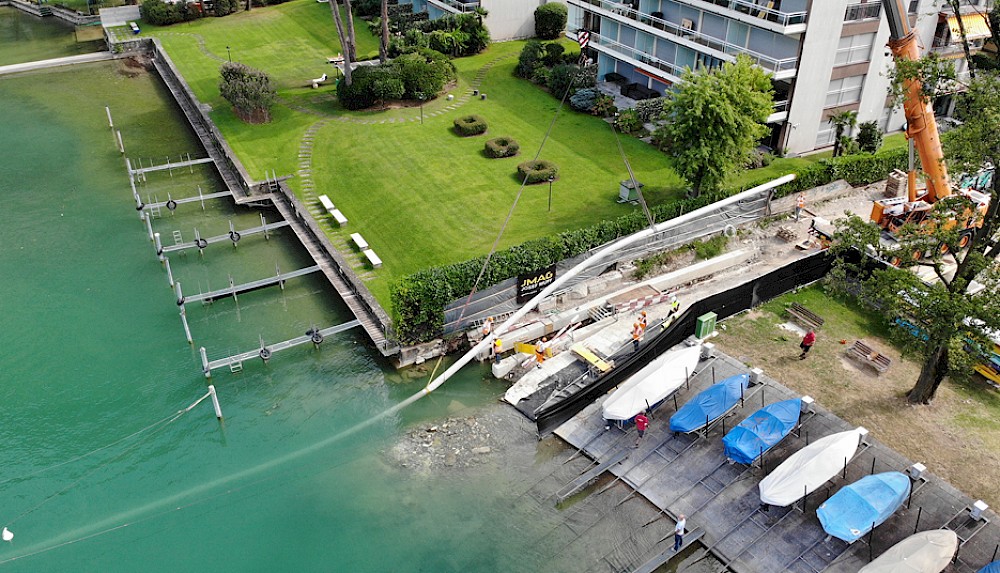Shortcut through the lake
To enhance supply security between the Lugano region and Mendrisiotto in the south of Switzerland, the Ticino utility company Aziende Industriali di Lugano (AIL) SA has built a new natural gas pipeline. The shortest, fastest and most economical route was through Lake Lugano – using HFI-welded steel pipes from Mannesmann Line Pipe.

The construction of the lake pipeline was completed on schedule in 20 months. Paradoxically, planning took two and a half times as long.«Andrea Quadri, AIL SA Project Manager
Teamwork with Indufer AG
In the course of well-versed cooperation, Mannesmann Line Pipe supplied around 380 HFI-welded steel pipes with an outer diameter of 323.9 mm and triple-layer PE coating via its long-standing Swiss distributor Indufer AG. The 16-meter-long steel pipes were supplied by truck as unusual loads approved by the canton of Ticino. For reasons of space, it was only possible to supply the pipes in instalments as construction work progressed.
The new 6.1 km long natural gas lake pipeline connects the communities of Bissone in the north and Capolago in the south of Lake Lugano. Due to the confined topographical conditions and to prevent disruption to traffic, the project managers opted for a connection through the lake. This involved far less excavation work and environmentally damaging movements of materials than laying the pipeline on land – a fact also reflected in the costs, with savings estimated at roughly 30 per cent.
Compliance with various nature conservation and environmental standards
The overall supervision of the work required elaborate coordination, especially with regard to the water and soil protection regulations as well as the environmental regulations for the protection of flora and fauna. A specialist was therefore appointed to monitor and ensure compliance with all regulations.

Pipe-laying on the shore at Capolago required a delicate touch from everyone involved. Photo: © Marketing Weiss+Appetito Gruppe
Welding on water and on land
On a specially erected welding stand, the pipes were first welded on land to form 96 m long strings. These were then welded together on an in-water track to form strings each 288 m long. To prevent uncontrolled sinking, suitably dimensioned floats were attached to the pipe strings.
Challenging lake shore
The biggest challenge, however, was the very uneven, craggy lake shore at Capolago. Here, to suit the profile of the shore, a pipe weighing approx. 5 t was cold-preformed on land and welded into a 350 m long floating pipe string. This required meticulous coordination between the crane operator, welders and the assembly team on the floating pontoon. The pipes were then bedded in the prepared shore trench. To protect the pipes from mechanical damage, the steel pipes were additionally coated with fibre cement mortar. The weld seams were subsequently isolated with corrosion protection tape and a cement bond.

The new low-pressure natural gas pipeline runs through Lake Lugano and supplies the southernmost part of Switzerland.

The pipe strings welded together on land were subjected to a pressure test at 7.5 bar.
GPS positioning in the lake
On the assembly pontoon, the other pipe strings were then welded together to form a continuous string, tested to ISO 9606-1, X-rayed and then pushed into the lake. Positioning was done by GPS so as to determine the exact location in 70 to 80 meters of water depth. Over time, the pipeline will sink into the layer of mud at the bottom of the lake.
Network redundancy improves supply security
The commissioning of the 4.9 bar lake pipeline in December 2022 has bolstered the region's existing supply network significantly. At the same time, there is now also network redundancy, thus also preventing future supply shortfalls in the event of maintenance work or disruptions and improving the security of supply in the entire region.
The fact that everything proceeded so smoothly and quickly was due to the impeccable coordination of all those involved – and certainly also to the shortcut through the lake.

